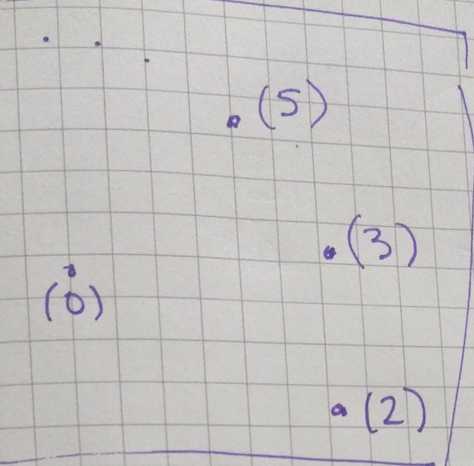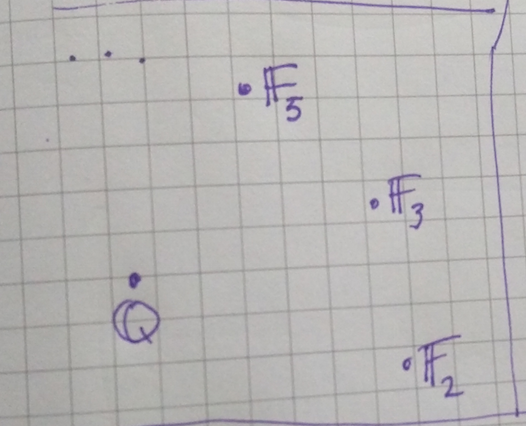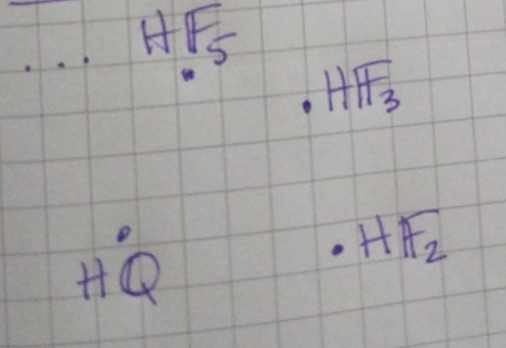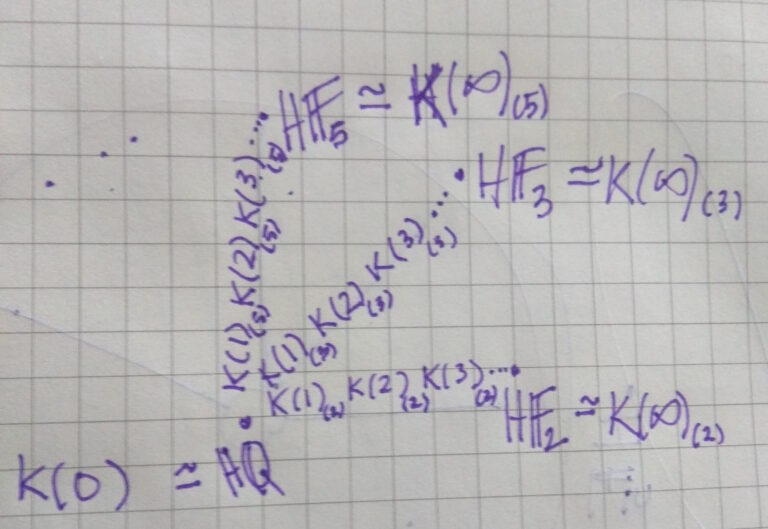What does the sphere spectrum have to do with formal group laws?
_This post assumes that you’re familiar with the definition of a prime ideal, a local ring, \( R_{(p)} \), the sphere spectrum, \(\mathbb{S}\), and the Lazard ring, \(L\). During a talk Jacob Lurie gave at Harvard this April, he labeled the moduli space of (1-d commutative) formal group laws as \(\text{Spec }\mathbb{S}\).
Eric Peterson kindly explained why \(\text{Spec }\mathbb{S} \simeq \text{Spec }L\) and I found his answer so lovely that I wish to share (all mistakes are due to me).
Why is \(\text{Spec }L\) iso to \(\text{Spec }\mathbb{S}\)?
This is part of the story of geometers working with higher algebra asking “what is an ideal of a ring spectrum?”
A ring \(R\) ——————-> category \(Mod_R \supseteq \mathrm{Perf}_R\) (finitely presented)
Note that \(\mathrm{Perf}R\) is the category of Perfect complexes of \(R\)-modules. A Perfect complex of \(R\)-modules is a chain complex of finitely generated projective \(R\)-modules \(P_i\), and is thus of the form \(0 \to P_s \to … \to P_i \to 0\)
The ring spectrum \(\mathbb{S}\) ——————-> category \(Mod_{\mathbb{S}} \supseteq \mathrm{Perf}_{\mathbb{S}}\)
Note that \(Mod_\mathbb{S} \simeq\) Spectra, and \(\mathrm{Perf}_\mathbb{S} \simeq\) Finite Spectra
A finite spectrum is a spectrum which is the de-suspension of \(\Sigma^\infty F\), where \(F\) is a finite CW-complex.
There’s a theorem by Balmer answering “what is an ideal in this context”, which points out this analogue:
\(\text{Spec }R\) as a space; \(p\) as a point (an element of \(\text{Spec }R\))
\(\mathrm{Perf}_R\) as a space; \(\mathcal{P}\) as a point (a subcategory of \(\mathrm{Perf}_R\))
satisfying that \(\mathcal{P}\) is:
- \(\otimes\)-closed against R-modules \(a \in \mathrm{Perf}_R; b \in \mathcal{P} \Rightarrow a \otimes b \in \mathcal{P}\)
- a thick subcategory of \(\mathrm{Perf}_R\) (i.e., it’s closed under cofiber sequences and retracts i.e., closed under extension)
A “prime ideal” of \(\mathrm{Perf}_R\) is a “proper thick tensor-ideal” \(P\) (\(\subsetneq \mathrm{Perf}_R\)) s.t.
\(a \otimes b \in \mathcal{P} \Rightarrow a \in \mathcal{P} \text{ or } b \in \mathcal{P}\)
So, if \( K_*(-) \) is a homology theory with Künneth isomorphisms \((K\_*(X \wedge Y) \simeq K\_*(X) \otimes\_{K\_*} K\_*(Y))\)
\[\Rightarrow \mathcal{P} = {X | K\_*(X) = 0} \text{ must be a “prime ideal”.}\]Sanity check of its “ideal-ness”:
\[K_*(X \wedge Y) \simeq K_* X \otimes K_*Y \simeq 0 \otimes K_*Y \simeq 0\]Here’s the surprising theorem that ties this prime ideal excursion into our original question (Periodicity Theorem: Hopkins and Smith):
- Any \(C \subset \mathrm{Perf}_{\mathbb{S}}\) arises in this way
- All homology theories with Künneth isomorphisms are Morava K-theories including \(Hk\) where \(k\) is a field, which is just the infinite Morava K theory \(K(\infty)_{(p)}\).
The proof of this is currently beyond my grasp, so I’m afraid I can’t talk you through it.
Taking this theorem’s proof as a black box, we’ve scraped together enough context to parse the answer of why \(\text{Spec }L \simeq \text{Spec }\mathbb{S}\).
Let’s look at \(\text{Spec }Z\):
let’s look at the residue classes of \(Z\):
and at \(\text{Spec }HZ \simeq \text{Spec }Z\), where the ring spectra \(HR\) represent \(H^*(-;R)\);
By the nilpotence theorem, the ideals of \(\mathbb{S}\) are the Morava K’s (one for each height and each prime)…
…so, \(\text{Spec }\mathbb{S}\) looks like \( \text{Spec }L\) (by a theorem of Lazard, 1-d formal group laws over separably closed fields of char p are classified up to iso by their height).
To be absolutely clear: for \(K(n)_{(p)}\); \((p)\) corresponds to the characteristic of the field (over which the formal group law is defined), while \(n\) corresponds to the height of the formal group law.
Afternote:
A comment of Lennert Meier’s on MO caught my interest. He mentioned that as the spectrum \(\ell\) (associated to a supersingular elliptic curve) is Bousfield equivalent to \(K(0) \vee K(1) \vee K(2)\) (with an implicit localization at a prime), we have \(\ell_*(K(A,n)) = 0\) for \(A\) finite abelian and \(n \geq 3\).
Note that \(F\) and \(E\) are Bousfield equivalent if for every spectrum \(X: F_(X)\) vanish iff \(E_(X)\). This is an equivalence relation on spectra.
Any elliptic cohomology is Bousfield equivalent to a wedge of Morava K-theories. Before we discard looking at individual elliptic cohomology theories, in favor of their “universal” counterpart with nice automorphisms, let’s look at the difference between \(K(0) \vee K(1)\) and complex K-theory, and try to lift these differences to those of \(K(0) \vee K(1) \vee K(2)\) and supersingular \(\ell\). It was pointed out to me that this is like comparing a local ring to its residue field.
To compute the Atiyah Hirzebruch spectral sequence of \(E^*(X)\), we need to know both the attaching maps in the space \(X\), and the attaching maps in the spectrum \(E\) (which I believe are called its Postnikov tower), both are hard (in most cases).
We currently only know how to compute the AHSS of \(\ell^*(X)\) when we have some map from \(CP^\infty \to X\) (since we define \(\ell\) using \(CP^\infty\)), for this map induces a map between spectral sequences.



